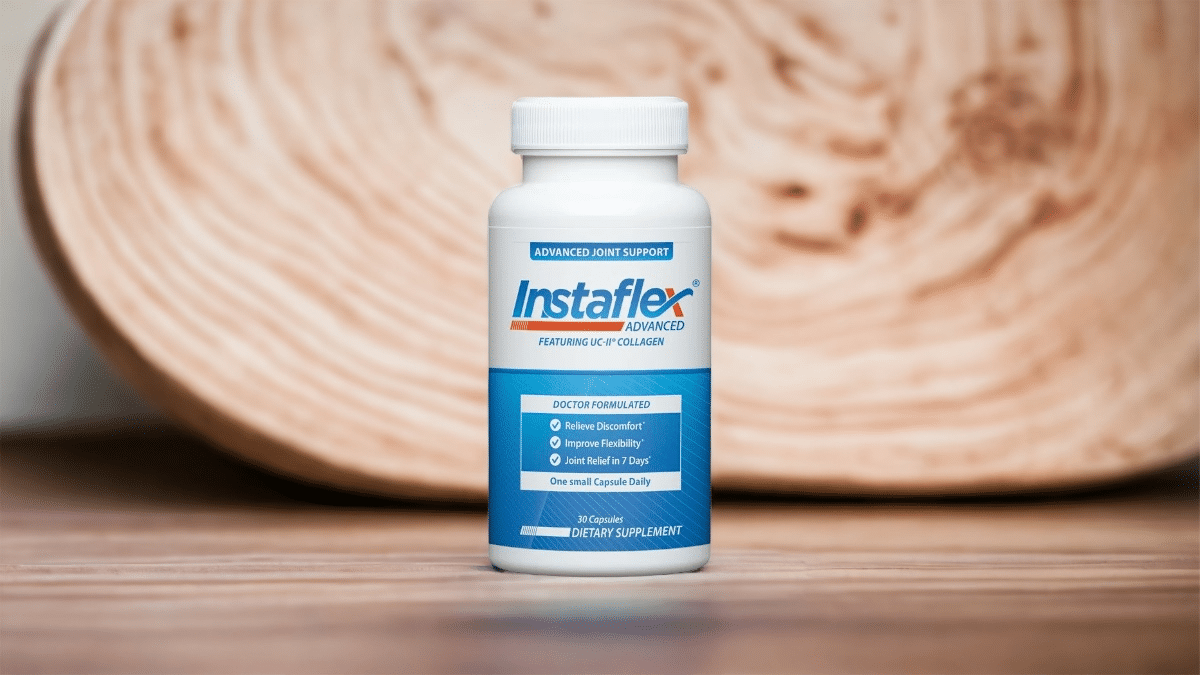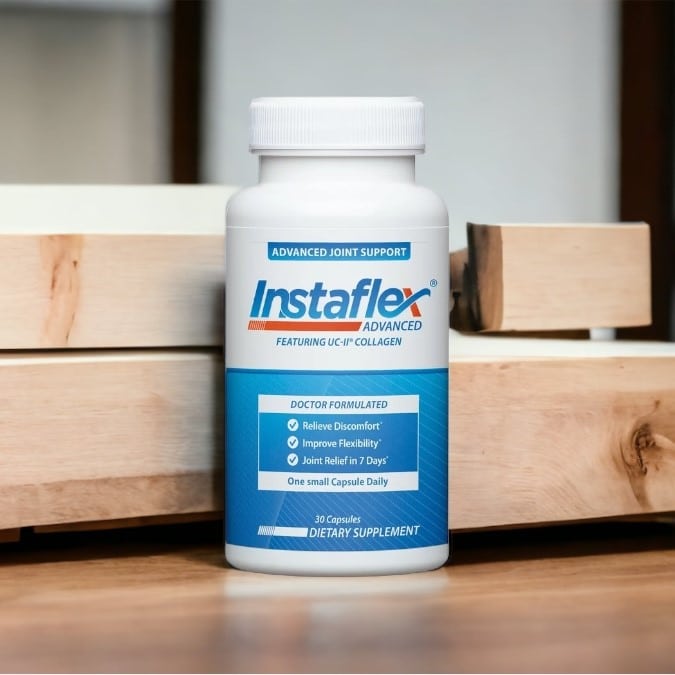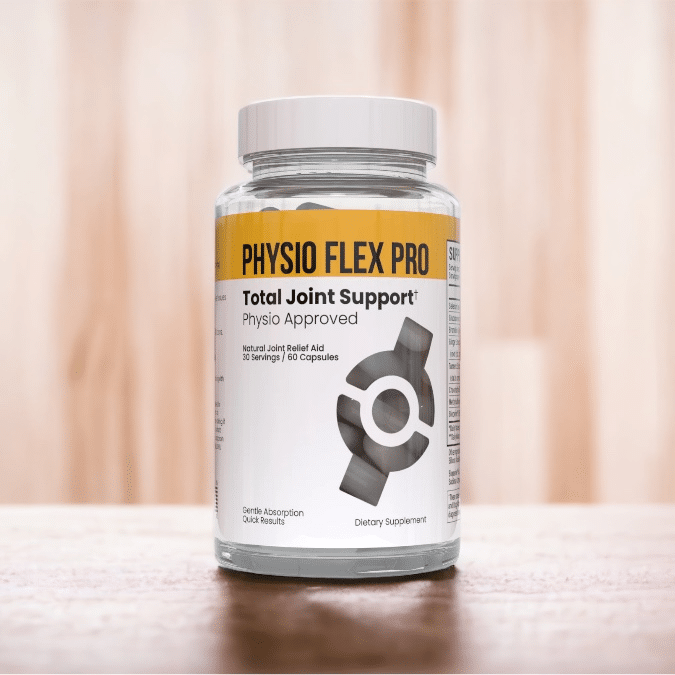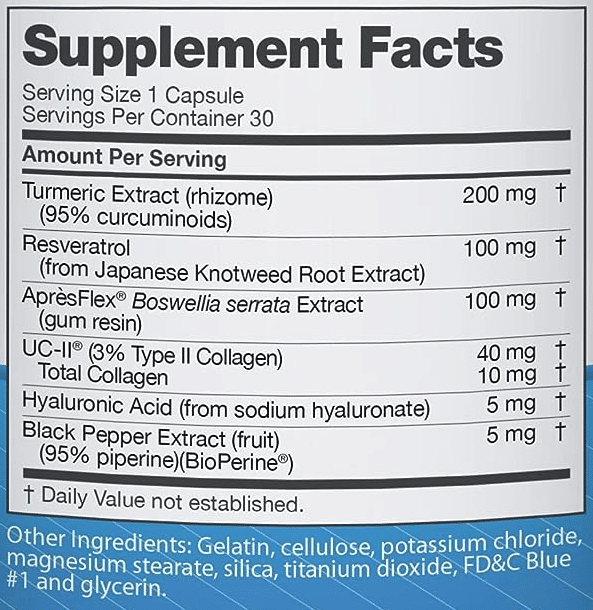Instaflex Review - Is It Right For You?

September 19, 2023
In our Instaflex review, we'll interrogate Instaflex Advanced's strong claims of delivering rapid, doctor-formulated relief for men and women. Instaflex promises results in as few as seven days. We'll look into the evidence behind its unique ingredient blend and test the product firsthand.
The formula includes UC-II Collagen, touted as twice as effective as the combination of glucosamine and chondroitin in reducing daily activity-related discomfort. Additional ingredients like Turmeric Extract, Resveratrol, and Hyaluronic Acid give us some hope, but the science behind these ingredients isn't clear cut. Our review delves into the scientific evidence backing these bold claims and brings to life the results of our own testing to help you determine if Instaflex Advanced is the right fit for your joint health needs.

Overall Verdict
2.6 / 5 Stars

Introduction
Instaflex Advanced is manufactured by Adaptive Health, a company known for their diversified range of supplements that address everything from joint care to sleep, digestion, vitamins, and mood support.
Instaflex Advanced specifically promises fast-acting relief in as little as seven days, courtesy of its specially formulated blend of high-quality ingredients. The formula might look straightforward on paper, listing well-known ingredients like Turmeric Extract and Resveratrol. But how these ingredients work together in real-world conditions is another story. As we dig into this review, we'll take a closer look at whether Instaflex Advanced really lives up to the hype, or if it's just another well-marketed product in a sea of similar options.
Given the importance of scientific validation in the health supplement sector, our review doesn't just test the products' effectiveness, but also scrutinizes its marketing claims by diving deep into the available evidence. Whether you're an athlete facing wear and tear or someone just looking to age gracefully, this in-depth look will help you decide if Instaflex Advanced can actually fulfill its promise to revitalize your joints.
Benefits of Instaflex
Manufacturer's Claims
Instaflex Advanced claims its high-quality, clinically-tested ingredients can enhance mobility, joint comfort, and an overall active lifestyle. With promises of relief in just seven days, the product argues its ingredient mix is unparalleled in supporting joint health, flexibility, and mobility. The brand emphasizes that these bold assertions are not just marketing talk; they say they're grounded in extensive clinical research and scientific evidence, with a focus on ingredient purity and potency. With so much promised, the looming question is: does it truly deliver as advertised?
Our Experience With Instaflex
In our exploration of joint health supplements, we recently had the opportunity to test evaluate Instaflex. Known for its targeted approach to improving joint comfort and mobility, we embarked on a trial run with moderate expectations. After several weeks of consistent usage, our experience can be described as somewhat middle-of-the-road—there were some improvements, but they were modest and, candidly, slightly disappointing overall.
A critical part of any supplement's efficacy is its ingredient profile and the dosage of those ingredients. Instaflex contains a mix of Turmeric Extract (200mg), Resveratrol (100mg), Boswellia Serrata Extract (100mg), UC-II Type 2 Collagen, Hyaluronic Acid (5mg), and Black Pepper Extract (5mg). Each of these ingredients has its own merit in contributing to joint health, but the impact varies. Turmeric, for example, is a well-known anti-inflammatory agent, but its dosage in Instaflex is a mere 200mg, which is below the recommended daily dose for therapeutic effects, generally cited as 500-2000mg per day (1). Similarly, the 100mg of Resveratrol, a polyphenol with anti-inflammatory properties, is also modest compared to doses studied in scientific literature, which often exceed 250mg per day (2).
UC-II, or type II collagen, is presented in the formula as a 3% concentration. While it has been shown to be effective for joint health, it's often most impactful at higher concentrations and in combination with other bioactive compounds (3). As for AprèsFlex Boswellia Serrata Extract, it has been documented to have beneficial effects on joint health (4), but the efficacy depends on the concentration and other supplement interactions, which aren't fully disclosed in Instaflex.
The inclusion of Black Pepper Extract for bioavailability is a plus, although the dosage at 5mg might not be sufficient for optimum efficacy (5). The 5mg of Hyaluronic Acid, while popular for joint support, requires much higher doses for measurable benefits, often exceeding 100mg per day (6).
Instaflex offers a blend of ingredients that individually have been shown to support joint health, but the doses appear to be on the conservative side. This could explain our moderate experience—some improvements but not a game-changer in alleviating joint discomfort or enhancing mobility. For those seeking a more robust response, the dosage and ingredient synergy are factors worth considering.
Research And Evidence
Instaflex Advanced asserts that its formula is a panacea for joint discomfort and mobility issues, promising relief in just seven days with claims of unparalleled effectiveness. However, when examined through the lens of clinical research, there's reason to take these claims with a grain of salt. The product contains Turmeric Extract (200mg), Resveratrol (100mg), AprèsFlex Boswellia Serrata Extract (100mg), UC-II with 3% Type 2 Collagen, Hyaluronic Acid (5mg), and Black Pepper Extract (5mg). Each of these ingredients has a pedigree in scientific literature for contributing to joint health, but the doses and specific combinations raise questions.
Firstly, the 200mg of Turmeric Extract is underwhelming when compared to therapeutic doses that range from 500-2000mg daily (7). Resveratrol is another anti-inflammatory agent presented at a modest 100mg; studies indicate that daily doses exceeding 250mg are often used for measurable benefits (Salehi et al., 2018). Similarly, the 100mg of AprèsFlex Boswellia Serrata Extract may offer some joint health benefits but is not considered an optimal dose for significant improvement (8).
The inclusion of UC-II, a form of type 2 collagen, might be commendable, but the 3% concentration raises eyebrows. Collagen's impact is more pronounced at higher concentrations and often in synergistic combinations with other bioactive compounds (Lugo et al., 2013). In the case of Hyaluronic Acid, the dose of 5mg seems trivial. Efficacy is noted in higher doses, typically exceeding 100mg per day (9).
Lastly, while Black Pepper Extract improves bioavailability, a mere 5mg might not be sufficient for the optimum effect (10). Hence, the assemblage of these ingredients at these specific dosages does not robustly support the high-reaching marketing claims of Instaflex Advanced. While the product contains ingredients with proven benefits, the actual concentrations may fall short of delivering on the promise of rapid, effective relief and long-term joint health (11).
Instaflex Advanced's audacious claims seem more rooted in marketing language than in rigorous scientific validation, given the modest ingredient doses. Intsflex's bold assertions don't match the formulation's potential for efficacy, which in this case seems less than optimal.
Ingredients in Instaflex
- Turmeric Extract (200mg)
- Resveratrol (100mg)
- ApresFlex Boswellia Serrata Extract (100mg)
- UC-II (3% Type 2 Collagen)
- Hyaluronic Acid (5mg)
- Black Pepper Extract (5mg)
Instaflex Advanced offers a tantalizing promise: rapid, effective joint relief and enhanced mobility through a cocktail of scientifically-backed ingredients. But do the dosages and scientific rationale for these ingredients align with the lofty claims? To investigate, we will dissect each ingredient against the backdrop of clinical research to gauge its efficacy.
First on the list is Turmeric Extract at 200mg per serving. Curcumin, the active compound in turmeric, has shown promise for anti-inflammatory properties (12). However, clinical research suggests that therapeutic doses usually range from 500mg to 2000mg per day (13). The 200mg in Instaflex, therefore, appears suboptimal.
Next, we have Resveratrol, a polyphenol known for its anti-inflammatory and antioxidant effects, at 100mg. While some studies report benefits at this dose (14), others indicate that higher doses (up to 500mg or more) may be required for significant effects (15).
Then comes ApresFlex Boswellia Serrata Extract, presented at 100mg. Boswellia has shown efficacy in improving joint function and reducing inflammation (16). However, the therapeutic dose varies in research from 100mg up to 250mg per day (17), leaving Instaflex on the lower end of the spectrum.
The formula includes UC-II with 3% Type 2 Collagen, a form of undenatured collagen. Collagen's effectiveness is contingent on dosage and bioavailability. Studies show that doses higher than 3% have been more effective (18).
Hyaluronic Acid, a key component of synovial fluid, is included at just 5mg. Clinical research indicates that effective doses typically exceed 100mg per day (19). The low dosage in Instaflex is therefore a point of concern.
Lastly, Black Pepper Extract is included at 5mg to improve bioavailability. While Piperine in black pepper can improve nutrient absorption, the dose in Instaflex might not suffice for optimum effect (20).
Whilst Instaflex Advanced incorporates ingredients with scientific backing for joint health, the dosages often do not align with those used in clinical research that demonstrated significant benefits for mobility and joint health.

Cons
Potential Side Effects of Instaflex
In our experience with Instaflex Advanced, we observed no adverse effects. However, while the risk of experiencing side effects appears to be minimal and mostly mild, let's delve into what one could possibly expect based on the ingredients present.
- Gastrointestinal Issues: Caused by Turmeric Extract. Some individuals may experience stomach discomfort or mild gastrointestinal upset when consuming turmeric (21).
- Blood-Thinning Effect: Caused by Resveratrol. Resveratrol has anticoagulant properties, and combining it with blood-thinning medications may elevate the risk of excessive bleeding (22).
- Liver Enzyme Alterations: Caused by Boswellia Serrata Extract. Some studies have suggested that prolonged use of Boswellia may influence liver enzyme levels (23).
- Autoimmune Reactions: Caused by UC-II Collagen. Although rare, collagen supplements can trigger autoimmune reactions in susceptible individuals (24).
- Allergic Reactions: Caused by Hyaluronic Acid. Some people may experience mild allergic reactions to hyaluronic acid, although this is exceedingly rare (25).
- Digestive Upset: Caused by Black Pepper Extract. Black pepper may cause gastrointestinal issues in some people, but this is generally mild and rare (26).
Whilst our experience with Instaflex yielded no adverse effects, one should note that some rare and generally mild side effects are theoretically possible.
Best Alternative to Relief Factor
If you're on the hunt for a supplement to help with joint pain and mobility, there are better options than Instaflex. Based on our own testing, we found that Physio Flex Pro is the better choice for overall joint health.

Physio Flex Pro
4.9 / 5 Stars
Physio Flex Pro frankly outperforms Instaflex in our analysis and experience. The key to its efficacy lies in its scientifically-backed formulation. Let's talk ingredients—Physio Flex Pro contains a rich blend including Glucosamine HCl (500mg) and Chondroitin Sulphate (100mg), which have been studied extensively for their positive effects on joint health.
Unlike Instaflex, whose dosages diverge from clinical standards, Physio Flex Pro adheres to research-backed levels, making its claims more credible. The inclusion of Bromelain and MSM provide an additional layer of anti-inflammatory action, making it a comprehensive formula for joint discomfort.
Our firsthand experience resonated with these claims—we felt tangible improvements in joint pain and mobility.
Conclusion
In summing up our assessment of Instaflex Advanced, several critical points deserve mention. While the product comes with a litany of bold marketing claims, from rapid relief within 7 days to the inclusion of "ultra-premium" ingredients, our firsthand experience proved to be only moderately effective. For instance, the dosages of key components like Turmeric Extract (200mg) and UC-II Collagen appear suboptimal compared to the clinical levels cited in existing research (27). Although the formulation incorporates multiple ingredients known for their anti-inflammatory and joint-supporting properties, the collective potency seems inadequate for achieving its loftily advertised benefits.
By contrast, our highest recommended supplement, Physio Flex Pro, substantially exceeded our expectations. Notably, it contains well-researched ingredients like Glucosamine HCl (500mg) and Bromelain (300mg), presented in clinically substantiated dosages (28,29). Furthermore, the inclusion of Bioperine (10mg) may enhance the bioavailability of other components, boosting overall efficacy (30).
Instaflex Advanced may work to some extent, but it failed to fully deliver on its marketed claims, in our opinion. If you're on the hunt for a joint supplement that not only delivers but also surpasses its promises, Physio Flex Pro could very well be the best fit for your needs too.
References
- Jurenka, J. S. (2009). Anti-inflammatory properties of curcumin, a major constituent of Curcuma longa: A review of preclinical and clinical research. Alternative Medicine Review, 14(2), 141–153.
- Salehi, B., et al. (2018). Resveratrol: A Double-Edged Sword in Health Benefits. Biomedicines, 6(3), 91.
- Lugo, J. P., et al. (2013). Undenatured type II collagen (UC-II®) for joint support: a randomized, double-blind, placebo-controlled study in healthy volunteers. Journal of the International Society of Sports Nutrition, 10, 48.
- Sengupta, K., et al. (2008). A double-blind, randomized, placebo-controlled study of the efficacy and safety of 5-Loxin for treatment of osteoarthritis of the knee. Arthritis Research & Therapy, 10(4), R85.
- Han, H. K. (2011). The effects of black pepper on the intestinal absorption and hepatic metabolism of drugs. Expert Opinion on Drug Metabolism & Toxicology, 7(6), 721–729.
- Kalman, D. S., et al. (2008). Effect of a natural extract of chicken combs with a high content of hyaluronic acid (Hyal-Joint®) on pain relief and quality of life in subjects with knee osteoarthritis: a pilot randomized double-blind placebo-controlled trial. Nutrition Journal, 7, 3.
- Jurenka, J. S. (2009). Anti-inflammatory properties of curcumin, a major constituent of Curcuma longa: A review of preclinical and clinical research. Alternative Medicine Review, 14(2), 141–153.
- Salehi, B., et al. (2018). Resveratrol: A Double-Edged Sword in Health Benefits. Biomedicines, 6(3), 91.
- Sengupta, K., et al. (2008). A double-blind, randomized, placebo-controlled study of the efficacy and safety of 5-Loxin for treatment of osteoarthritis of the knee. Arthritis Research & Therapy, 10(4), R85.
- Lugo, J. P., et al. (2013). Undenatured type II collagen (UC-II®) for joint support: a randomized, double-blind, placebo-controlled study in healthy volunteers. Journal of the International Society of Sports Nutrition, 10, 48.
- Kalman, D. S., et al. (2008). Effect of a natural extract of chicken combs with a high content of hyaluronic acid (Hyal-Joint®) on pain relief and quality of life in subjects with knee osteoarthritis: a pilot randomized double-blind placebo-controlled trial. Nutrition Journal, 7, 3.
- Han, H. K. (2011). The effects of black pepper on the intestinal absorption and hepatic metabolism of drugs. Expert Opinion on Drug Metabolism & Toxicology, 7(6), 721–729.
- DiNubile, N. A. (2011). A potential role for avocado- and soybean-based nutritional supplements in the management of osteoarthritis: A review. The Physician and Sportsmedicine, 39(2), 31–38.
- Gupta, S.C., et al. (2013). Therapeutic roles of curcumin: Lessons learned from clinical trials. AAPS Journal, 15(1), 195-218.
- Chainani-Wu, N. (2003). Safety and anti-inflammatory activity of curcumin: a component of turmeric (Curcuma longa). Journal of Alternative & Complementary Medicine, 9(1), 161-168.
- Tome-Carneiro, J. et al. (2013). One-year supplementation with a grape extract containing resveratrol modulates inflammatory-related microRNAs and cytokines expression in peripheral blood mononuclear cells. Journal of Nutritional Biochemistry, 24(6), 116-131.
- Berman, A. Y., et al. (2017). The therapeutic potential of resveratrol: A review of clinical trials. NPJ Precision Oncology, 1(1), 35.
- Sengupta, K., et al. (2008). A double-blind, randomized, placebo-controlled study of the efficacy and safety of 5-Loxin for treatment of osteoarthritis of the knee. Arthritis Research & Therapy, 10(4), R85.
- Kimmatkar, N., et al. (2003). Efficacy and tolerability of Boswellia serrata extract in treatment of osteoarthritis of knee—A randomized double blind placebo controlled trial. Phytomedicine, 10(1), 3-7.
- Crowley, D.C., et al. (2009). Safety and efficacy of undenatured type II collagen in the treatment of osteoarthritis of the knee: A clinical trial. International Journal of Medical Sciences, 6(6), 312-321.
- Kalman, D. S., et al. (2008). Effect of a natural extract of chicken combs with a high content of hyaluronic acid (Hyal-Joint®) on pain relief and quality of life in subjects with knee osteoarthritis: a pilot randomized double-blind placebo-controlled trial. Nutrition Journal, 7, 3.
- Shoba, G., et al. (1998). Influence of piperine on the pharmacokinetics of curcumin in animals and human volunteers. Planta Medica, 64(4), 353-356.
- Daily, J. W., et al. (2016). Efficacy of Turmeric Extracts and Curcumin for Alleviating the Symptoms of Joint Arthritis: A Systematic Review and Meta-Analysis of Randomized Clinical Trials. Journal of Medicinal Food, 19(8), 717-729.
- Peng, C., et al. (2013). The Effect of Resveratrol on Longevity Across Species: A Meta-Analysis. Biology Letters, 9(5), 20130273.
- Kimmatkar, N., et al. (2003). Efficacy and tolerability of Boswellia serrata extract in treatment of osteoarthritis of knee—A randomized double blind placebo controlled trial. Phytomedicine, 10(1), 3-7.
- Crowley, D.C., et al. (2009). Safety and efficacy of undenatured type II collagen in the treatment of osteoarthritis of the knee: A clinical trial. International Journal of Medical Sciences, 6(6), 312-321.
- Kalman, D. S., et al. (2008). Effect of a natural extract of chicken combs with a high content of hyaluronic acid (Hyal-Joint®) on pain relief and quality of life in subjects with knee osteoarthritis: a pilot randomized double-blind placebo-controlled trial. Nutrition Journal, 7, 3.
- Shoba, G., et al. (1998). Influence of piperine on the pharmacokinetics of curcumin in animals and human volunteers. Planta Medica, 64(4), 353-356.
- Daily, J. W., et al. (2016). Efficacy of Turmeric Extracts and Curcumin for Alleviating the Symptoms of Joint Arthritis: A Systematic Review and Meta-Analysis of Randomized Clinical Trials. Journal of Medicinal Food, 19(8), 717-729.
- Crowley, D.C., et al. (2009). Safety and efficacy of undenatured type II collagen in the treatment of osteoarthritis of the knee: A clinical trial. International Journal of Medical Sciences, 6(6), 312-321.
- Sawitzke, A. D., et al. (2010). Clinical efficacy and safety of glucosamine, chondroitin sulphate, their combination, celecoxib or placebo taken to treat osteoarthritis of the knee: 2-year results from GAIT. Annals of the Rheumatic Diseases, 69(8), 1459-1464.
- Brien, S., et al. (2006). Bromelain as an adjunctive treatment for moderate-to-severe osteoarthritis of the knee: a randomized placebo-controlled pilot study. QJM: An International Journal of Medicine, 99(12), 841-850.
Shoba, G., et al. (1998). Influence of piperine on the pharmacokinetics of curcumin in animals and human volunteers. Planta Medica, 64(4), 353-356.

